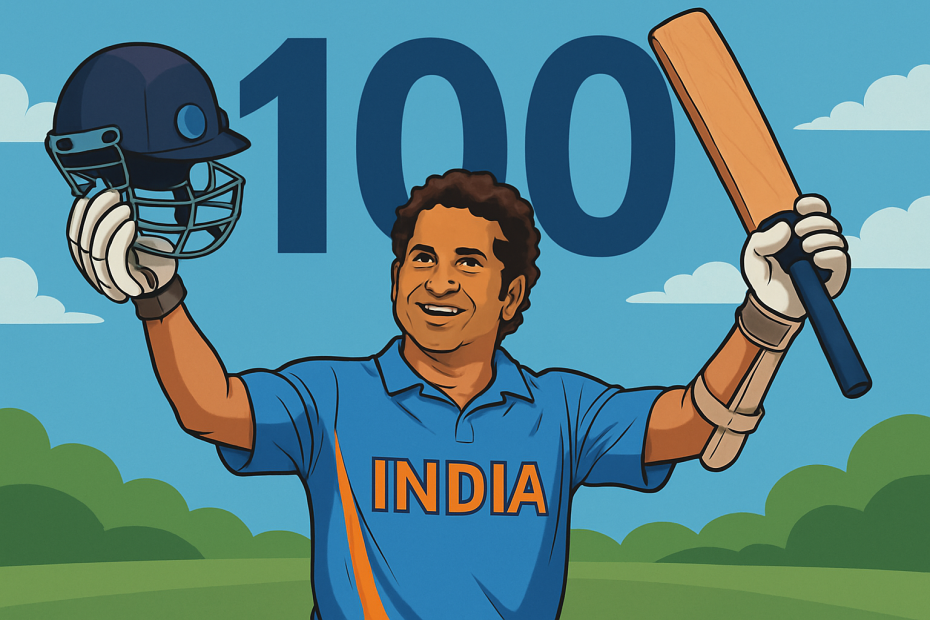Quick answer up front
Sachin Tendulkar scored 100 international centuries: 51 in Tests and 49 in One-Day Internationals. That’s the all-time record for most international hundreds.
Key facts at a glance
- First Test century: 119* vs England, Manchester (fourth innings, match saved)
- First ODI century: 110 vs Australia, Colombo (RPS)
- 100th and last international century: 100 vs Bangladesh, Mirpur (ODI)
- Highest Test score: 248*
- Highest ODI score: 200*
- Test double centuries: 6
- ODI centuries while opening: 45
- ODI centuries in chases: 17
- World Cup centuries: 6
- Most centuries vs any team (across formats): Australia (20)
- T20 International centuries: 0
Introduction: The anatomy of a hundred hundreds
There are records you browse and records you remember. Sachin Tendulkar’s centuries belong to the second kind—the sort that are wrapped in context, weighted by pressure, and scented with the old leather of the ball. You don’t just recall the number on the scoreboard; you recall the conditions and the company, the bowling plan swirling around him, the roughened patches outside off stump, the way the field moved when he walked in. You recall how often the television volume rose when he went from 90 to 100.
“Sachin Tendulkar centuries” as a phrase looks clinical in a search bar. In the memory of anyone who watched him, it’s textured. It covers the Manchester rescue, the Perth defiance, the Chennai heartbreak, the Sharjah sandstorm, the Sydney masterpiece, the Gwalior double. It spans two formats, multiple eras of bowling, and a constantly evolving bat swing tuned to every continent.
This piece is an expert’s hub for Tendulkar’s hundred hundreds—what they were, where they came, and why they mattered. It includes format breakdowns, opposition and venue insights, milestone knocks that shaped series, and an editorial layer on impact that raw lists often miss. You’ll find the canonical totals, the first and the last, the peaks and droughts, the fourth-innings courage, the chase craft, and the quiet ruthlessness of a batter who made scoring a hundred look like a ritual.
Sachin Tendulkar total centuries: headline numbers and how to read them
- International centuries: 100
- Test centuries: 51
- ODI centuries: 49
- T20I centuries: 0
Framing matters. A hundred hundreds spread across two formats reflect durability as much as excellence. Tendulkar’s Test hundreds show a method for all seasons and surfaces, while his ODI hundreds show a revolutionary shift—when he moved to the top of the order and turned the first powerplay into a batting laboratory. Consider these lenses while reading this archive:
- Format contexts: Test hundreds carry match-time length, second- and fourth-innings difficulty, and the need to rebuild and reset. ODI hundreds require tempo management, strike-rate calibration, and a near-telepathic feel for field restrictions.
- Opposition quality and matchup patterns: Tendulkar’s catalogue is studded with dozens against high-quality pace and elite spin. Multiple centuries against Australia across formats define his apex.
- Venue and pitch style: From bounce and seam to turn and drift, he refined guard position, bat path, and scoring zones to suit the surface.
- Match impact beyond the score: The same 100 can mean different things in different chases or on different fifth-day minefields.
Sachin Tendulkar Test centuries: a complete, lived-in view
Tendulkar’s 51 Test centuries are the spine of his batting story. The innings don’t just stack—they evolve. The early ones bristle with defiance; the middle-phase knocks are sculpted masterpieces; the later years are economy of movement and a veteran’s shot library.
How the Test hundreds were built
- Positioning: Predominantly at number 4, the role that demands both early-crisis repair and mid-innings acceleration. It also often places the greats against the new ball’s second wind.
- Scoring patterns: A signature early back-foot punch through cover on bounce-heavy tracks; the long-lever straight drive once set; soft hands against high-class spin; the workmanlike singles that stitch his big scores together.
- Risk profile: Remarkably low early dismissal risk, then selective bursts—sweep against spin after the first hour, dancing feet once he had the bowler’s lengths mapped.
Notable Test centuries that define the arc
- Manchester 119*: The boy who saved a Test with technique that looked older than the team. Fourth-innings hundreds test temperament more than talent; this one announced both.
- Perth 114: Against hard length and pace, at a venue that exposes technique. The back-foot play here became a manual for touring batters.
- Chennai 155 vs Australia: A series-shifting statement against a champion attack, featuring calculated violence against leg-spin and a ruthless second-day follow-through.
- Cape Town 169: A rearguard classic alongside an attacking partner, mixing counterpunch with monk-like patience in a match that stressed India’s middle order.
- Chennai 136 vs Pakistan: A heartbreaking fourth-innings epic that ended in defeat. It is impossible to tell the story of his hundreds without including the ones that cut deep in losses.
- Chennai 103* vs England: A fourth-innings chase cloaked in significance beyond sport, finished with a gentle glide through midwicket that seemed to release a nation’s tension.
- Sydney 241*: A dissertation on shot selection—leaving out the cover drive for hours to deny a trap, then expanding in layers once the bowlers were blunted.
- Galle/Colombo 200-plus series: High-class double hundreds on turning surfaces against strong spin, proving his forward press and late cuts were built for the long haul.
- Nagpur 201*: The patient, almost meditative double against seam and swing under a broiling sun, a masterpiece of attrition.
- Cape Town 146: One of the final Test hundreds, a reminder that in South Africa’s conditions his back-foot geometry remained undisturbed.
Test double centuries
He registered six doubles in Tests, spread across subcontinental turn, southern-hemisphere bounce, and conditions in between. The spread matters; double hundreds gained away from home emphasize problem-solving under unfamiliar bounce and lateral movement.
Fourth-innings Test centuries
He owns fourth-innings hundreds that live in the game’s folklore, beginning with Manchester and peaking emotionally with Chennai against England. They highlight two of his rarest traits in the same innings: no rush, no panic; and just enough decisiveness to keep the chase from stagnation.
Sachin Tendulkar ODI centuries: from opener to pace-setter
Tendulkar’s 49 ODI centuries didn’t arrive until he claimed the new ball as his ally. Once he became an opener, the format was never the same. He mapped powerplay gaps before the term became fashionable, drove on the up when bowlers dared, and checked the team’s scoring tempo like a second scoreboard in his head.
DNA of the ODI hundreds
- Batting position: 45 of his ODI hundreds came as an opener. The remainder underlined his flexibility when circumstances demanded a shift.
- Chases vs first-innings: He was a master at pacing chases, with 17 tons while batting second. These weren’t all blitzes; many were measured scaffolding to let others explode around him.
- Acceleration model: Low-risk boundary options in the first fifteen overs; strong running when fields spread; decisive targeting of matchups in the middle overs against change bowlers.
ODI hundreds that changed what teams expected from openers
- Colombo 110 vs Australia: The long-awaited first ODI ton; the relief was audible through the television. It confirmed that his powerplay tempo wasn’t just a cameo style.
- Sharjah 143 and 134 vs Australia: The desert storm series—one to drag a team into a final on net run rate, another to win the title. The two innings together popularized a template: one man sets the chase, everyone else feeds off the storm.
- Hyderabad explosiveness vs New Zealand: A lightning tempo hundred that expanded his white-ball vocabulary to include the mid-innings launch, not just early powerplay slicing.
- Gwalior 200*: The first male double in ODIs, built like a long-form innings with modern powerplay aggression, then a measured brutality once fielders went to the rope. No slogging, just the sound of a perfect bat swing through a tiring ball.
- Asia Cup centuries: A spread across rivals, including the hundred that gave him the three-figure milestone few imagined was possible—his hundredth international century at Mirpur.
World Cups, Champions Trophy, and Asia Cup hundreds
- World Cups: Six ODI World Cup centuries, across different editions and conditions. The conversion rate here matters—he wasn’t just consistent; he spiked when the stage demanded it. He mixed hundreds against Associates with defining knocks against full members, setting up big tournament totals and chases with the calm of a man reading ahead in the script.
- Champions Trophy and its predecessor: Centuries that dragged India through knockout phases, including a towering statement against Australia at Nairobi that neutralized a top-quality attack with old-school shots and new-age intent.
- Asia Cup: A reliable bank, often a stage where his ODI hundreds felt inevitable. The milestone hundred at Mirpur sits at the heart of that narrative.
Centuries by opposition: the hardest exams, the highest marks
Opposition quality shapes how we remember a batter’s hundreds. Tendulkar sat the toughest papers and passed in red ink.
Australia (20 across formats)
This is the series within the saga. Tests in Australia produced a suite of innings that disarmed bounce and punished length. ODIs against them made run-chases look negotiable against champion attacks. Eleven Test hundreds, nine ODI hundreds—if you’re choosing the axis on which to analyze Sachin, this is it.
Pakistan
Pressure begins before the toss in these fixtures. He crafted fourth-innings drama in Chennai and silenced volatile new-ball spells with soft hands and late movement. Even when not converting to triple digits, his assault on new-ball pairings set up games others finished. The hundreds he did score stand as masterclasses on playing high-pace and quality reverse swing.
England
A beginning and a mid-career flourish. The Manchester rescue job, the Chennai chase win, and a collection of overseas hundreds where swing demanded narrow bats and narrow margins. He respected the moving ball, then let it know who was in charge.
South Africa
A country where many greats discover the truth about their technique. His centuries at Cape Town and elsewhere proved he could ride the bounce and take toll of anything short. His batting here was an essay on weight transfer and late hands.
Sri Lanka
Dozens of battles against world-class spin in the heat. He played deep into the crease to make spin re-pitch and used the sweep, the walk, and the delayed cut until bowlers lost lengths they’d grown up trusting.
New Zealand, West Indies, Zimbabwe, Bangladesh
The hundreds here reflect something fans sometimes underestimate—a refusal to take any opposition lightly. He built as if facing the strongest attacks because that’s how he trained his muscle memory.
Centuries by venue and country: maps and methods
It isn’t just who you score against; it’s where.
Australia
The SCG was a cathedral for him. The 241*—with the cover drive left in the bag for hours—has become a coaching parable. Perth proved he could take pace early in his career and still own it later. Across Adelaide, Melbourne, Sydney, and Perth, his hundreds read like an essay on recalibration: guard adjustments, compact back-and-across movement, and severe punishment of anything fractionally short.
England
Manchester for the rescue. Elsewhere across England, he built hundreds by playing late, letting the seam do its dance and meeting the ball once it finished. It takes discipline to check the cover drive in swing; he made restraint look beautiful.
South Africa
A batting seminar on short-of-a-length balls. He met bounce with poise and made a home for his punches behind point and through extra-cover. Centurion and Cape Town hold some of his finest away acts.
Sri Lanka
Colombo and Kandy turned into laboratories for spin control. You could measure an opposition spinner by how quickly he abandoned his stock ball against Tendulkar.
UAE
Sharjah carried the myth of the sandstorm. Beyond the narrative, look at the specifics: his hitting zones in the death overs, the way he targeted the shorter boundaries with conventional, not slog, mechanics.
India
Across Mumbai, Chennai, Kolkata and more, he played the pitches many in the opposition did not understand. You often saw visiting bowlers get lost in the dry heat; Tendulkar thrived, not by blasting, but by picking singles like a man counting raindrops.
By batting position: why number 4 in Tests and opening in ODIs mattered
Tests at number 4
The position demands both emergency triage and long-game patience. Many of his most important centuries started in trouble: early wickets gone, ball new and motivated. He built partnerships with senior pros, mentored younger partners mid-innings, and often became the hinge between two halves of the batting card.
ODIs as opener
Those 45 hundreds at the top are no accident. He immediately tested new balls and field positions, turned dot balls into time wins through running, and punished anything loose to ensure India never drifted in the first twenty overs.
Sachin Tendulkar centuries in chases: the quiet science of timing
Chasing is a different sport inside the same game. It’s the art of resisting the rush while keeping the ask under control. Tendulkar scored 17 ODI centuries in successful chases or near-misses, and the pattern is familiar once you’ve tracked them closely:
- Always a reading phase: The first five overs were data collection. Where did the ball stop? Which end offered grip? Who could be milked later?
- A middle-overs squeeze: Singles at will, boundary every over or two, so the asking rate couldn’t threaten.
- The final kick: Rarely flashy. He left the finishing flourish to a power-hitter partner if available; otherwise, he chained high-value shots through gaps he’d programmed into the field.
Fastest and slowest by feel, not by stopwatch
His most exhilarating hundreds weren’t always the quickest by balls faced; they felt fast because they pulled games into India’s orbit early. Conversely, some of the slowest were the most essential—made on tracks where boundaries came like bus schedules, infrequent and unreliable, or in fourth innings where the moment begged for restraint.
The century droughts: what look like deserts are often disguised orchards
Between his 99th and 100th, every ball seemed to carry a whisper. He kept batting for the team; the hundred, when it came at Mirpur, felt like the quietest release of pressure on a loud ground. The lesson through the droughts: nothing in his method changed except the noise around it. Where others chase milestones, he continued to chase situations.
Sachin Tendulkar world cup centuries: platform, peak, and presence
Six World Cup centuries sit in his profile like medallions, some against top-tier attacks, others against lighter opposition when net run rate or table position demanded clarity. His World Cup hundreds follow three recurring themes:
- Setting a tournament tempo: Early hundreds that defined India’s batting approach for the rest of a campaign.
- The chase anchor: Holding nerve in tall chases, particularly when wickets fell in clumps at the other end.
- The one with gears: Starting against the new ball outside off, then unfurling the straight drive once he read the swing, followed by the sweeps and lofts after the change bowlers arrived.
Asia Cup and Champions Trophy hundreds: regional and global tune-ups
- Asia Cup: Conditions familiar, rivalries intense. He played these like domestic finals—taking risk only when the economy of runs demanded it. The Mirpur hundred sits apart for its milestone weight, but the rest underline a habit: whenever fields went out early against him, he punished that timidity.
- Champions Trophy/ICC Knockout: The Nairobi masterpiece against Australia is retold for a reason. It straddled eras—classic technique against a world-class attack, with modern tempo.
Against Australia: the private rivalry inside a public career
If you plotted his career as a chart, the Australia line would be the most jagged and the most thrilling. Their best came at him, home and away. And across formats he returned double-digits in centuries.
Why he hurt them so often
- Against high pace: His back-and-across movement kept him aligned even at top speed. The pull, the uppercut, the punch through cover—these were not risk but control.
- Against elite leg-spin: The Chennai masterclass stands as a plan perfectly executed—charge when it’s right, go back and across when it’s too full, deny the stock ball, force the variation.
- In ODIs: He took their powerplay pride and attacked it, not with slog, but with precise open-face carving and straight hitting that made fields look too small.
Against Pakistan: technique meets temperament
In the white heat of India–Pakistan fixtures, he often played the legislator, cooling tempers by making the ball do his bidding. Hundreds here were achieved under conditions that usually make batters overreach—reverse swing at speed, fields chirping, movement with bluff.
Against England and South Africa: the examiners abroad
- England’s swing: He accepted movement as a temporary power and played it later than most. Hundreds here felt like long negotiations, where he always got the rate he wanted.
- South Africa’s bounce: Hundreds are hardest here. He took body-line out of the equation with soft hands and right angles, cutting anything back-of-a-length and driving only on invitation.
Near-misses and the 90s list: the magnetism of almost
He wore the 90s with equanimity that belied the noise around them. There were many—more than most—but each near miss was usually evidence of intent, not anxiety: taking on a field to keep a chase alive, or the willingness to stretch a chance to get India ahead of the game.
By year and period: phases, not calendars
- The prodigy phase: Hands too soft for the age, feet already clinical. Early hundreds often came against the run of play in teams that leaned on older names.
- The master craftsman phase: The cover drive’s volume lowered, the straight drive’s frequency higher; heavy-scoring bursts across series taught bowlers that patience was not enough against him.
- The elder statesman phase: Plenty of hundreds built on experience—using angle, using field, using the bowler’s pace. He left the big backlift in the bag and used fine-tuning to wear attacks down.
The tactical toolkit behind the centuries
- Ball-reading: He read length so early it felt unfair. That’s why he often hit on the rise without looking like he gambled.
- Hands: Soft through impact against seam. Watch his edges—they rarely carried.
- Feet: Silent early, skipping and dancing late. The advance against spin was measured to the millimetre.
- Mind: Almost nothing forced. Milestones did not change shot selection; match states did.
- Fitness: Understated but relentless. He ran his partners into good habits and ran attacks into fatigue.
Sachin Tendulkar last century: a milestone without fireworks
Mirpur. An ODI hundred, dead-center in the scoreboard and in the story of the sport: the 100th international century. It didn’t come with the fireworks of Sharjah or the serenity of Sydney; it came with relief. Milestones can look like ends. In his case, the end had already been earned many times over; this one just gave it a neat bow.
Sachin Tendulkar firsts: where the journey took shape
- First Test hundred: Manchester. He was not supposed to be so unhurried, so certain, at that age. With a pitch that still had ideas and a match in the balance, he refused both the rush and the lure of flourish.
- First ODI hundred: Colombo. The grind ended, the floodgates opened. From that point, the ODI hundreds arrived in clumps, like summer storms.
By the numbers, beyond the obvious
A short table of hard counts that matter for readers who track records as seriously as they track memories.
Essential Tendulkar century numbers
| Category | Value |
|---|---|
| International centuries | 100 |
| Test centuries | 51 |
| ODI centuries | 49 |
| Test double centuries | 6 |
| Highest Test score | 248* |
| Highest ODI score | 200* |
| ODI centuries as opener | 45 |
| ODI hundreds in chases | 17 |
| World Cup centuries | 6 |
| Most international centuries vs one opponent | 20 vs Australia |
| T20I centuries | 0 |
| Hundreds at the SCG | multiple; includes 241* |
| International hundreds at Lord’s | none |
Sachin Tendulkar centuries vs Virat Kohli: eras, not enemies
The comparison draws clicks; what it deserves is nuance. Tendulkar pioneered the opening-batter-as-enforcer model in ODIs, carried the weight of a billion eyes before every broadcast carried a stump mic, and negotiated pace eras that stacked champion attacks across tours. Virat Kohli refined the chase blueprint in ODIs on batting surfaces that reward target-based calculation, adding freakish consistency to the template Sachin drafted.
- International centuries: Tendulkar still sits on top with 100.
- ODI centuries: The mark of 49 has been overtaken, but it set the scale for what was thinkable.
- Tests: Tendulkar’s 51 remains the gold standard for an Indian batter.
Different conditions, different balls, different fielding standards. The right way to read both careers is not with a finger on the scale, but with two hands applauding across generations.
Editorial shortlist: 25 Sachin Tendulkar centuries that shaped matches and minds
A curated list of innings that blend statistical weight with match context. These are the ones coaches play in dressing rooms and parents tell their cricket-crazy kids about.
- Manchester 119* vs England, Test: Fourth-innings rescue when everything said fold. Technique wearing a teenager’s face.
- Perth 114 vs Australia, Test: Bounce as exam; back-foot as answer key.
- Sydney 148*, Test: The apprenticeship complete, announced in one of cricket’s great theaters.
- Leeds 193, Test: The gift of time harnessed into a monolith; partnerships mattered more than flair.
- Chennai 155 vs Australia, Test: Leg-spin met a plan so precise it should be hung in coaching rooms.
- Cape Town 169, Test: Counterpunching under pressure, a masterclass alongside a flamboyant partner.
- Chennai 136 vs Pakistan, Test: Beauty in defeat; a knock that still hushes rooms when mentioned.
- Chennai 103* vs England, Test: The calm finish in a chase drenched with emotion beyond the scoreboard.
- Sydney 241*, Test: The leave as a weapon; the cover drive sheathed for the greater good.
- Galle 203, Test: Patience under turn and drift; feet always right, hands always late.
- Nagpur 201*, Test: Heat-tested concentration, attack by accumulation.
- Cape Town 146, Test: The elder statesman on a fast deck, choosing violence only when invited.
- Colombo 110 vs Australia, ODI: First ODI hundred; wires cut, engine revved.
- Sharjah 143 vs Australia, ODI: Storm-blown savagery to qualify for the final.
- Sharjah 134 vs Australia, ODI: The trophy clincher, a continuation of intent.
- Hyderabad 186* vs New Zealand, ODI: A masterclass in timing acceleration; fielders looked small, bat looked broad.
- Gwalior 200*, ODI: The frontier broken with classic strokes and relentless fitness.
- Nairobi 141 vs Australia, ICC Knockout: Big attack, big stage, big answer.
- Dhaka 134 vs Pakistan, ODI: Derby pressure meets serenity.
- Jamshedpur 146 vs Zimbabwe, ODI: Control disguised as comfort.
- Kolkata 105* vs West Indies, Test: At home, under lights that amplify expectation.
- Multan 194 vs Pakistan, Test: A score that made a defense look ornamental.
- Mohali 141 vs Australia, Test: Tempered aggression in a heavyweight duel.
- Kolkata 175 vs Australia, ODI: A last great throwback in a high-scoring thriller.
- Mirpur 100 vs Bangladesh, ODI: The hundredth; destiny stamped without fuss.
Centuries in winning causes: the impact layer
The ratio tilts to “wins” in ODIs—a consequence of his chase management and powerplay mastery. In Tests, dozens of match-shaping hundreds came in draws and hard-fought away assignments where batting fourth or second against the grain demanded a different kind of bravery. Not every decisive innings is a winning innings; many were foundation-laying stalemates abroad that mattered just as much for the confidence of traveling teams.
Batting position splits: the geometry of a role
- Test number 4: His centuries here often built the scaffolding for others. Scorecards frequently show a pattern: early wicket, stabilizing stand, expansion once the ball got old, then a partnership avalanche.
- ODI opener: The new ball was an ally, not a threat. He opened up cover from ball one, ran like a middle-order runner in the death overs, and treated the first ten like a leverage point rather than a quiet hour.
How to read “slow” hundreds: purpose, not pace
In away Tests, slow hundreds were by design. The slower the surface, the more important each leave became. The problem with judging by strike-rate is that it ignores pressure’s weight; the scoreboard asks you to hurry just when the pitch punishes ambition. Tendulkar’s slowest hundreds have an afterglow you understand only if you watch every ball.
Sachin Tendulkar at Lord’s: the one box left unticked
He did not score an international century at Lord’s. Across a hundred hundreds, he left this single square blank—proof that even the greatest leave the game a small, human smudge.
Questions fans always ask, answered crisp
- How many international centuries did Sachin Tendulkar score?
100, the most by any player. - How many Test centuries did he score?
51. - How many ODI centuries did he score?
49. - Did he ever score a T20 International century?
No. - Who broke his ODI centuries tally?
Virat Kohli went past his ODI mark, while Tendulkar’s total across formats remains the benchmark. - Which team did Sachin score the most centuries against?
Australia, with 20 across formats. - Where did he score his first and last international hundreds?
First Test hundred in Manchester, first ODI hundred in Colombo (RPS), last international hundred in Mirpur. - What are his highest scores in each format?
248* in Tests; 200* in ODIs. - How many World Cup centuries did he score?
Six. - Did he get more ODI hundreds while opening?
Yes—45 of his ODI centuries came as an opener.
The craft that made the hundreds inevitable
- Ball-reading: He read length so early it felt unfair. That’s why he often hit on the rise without looking like he gambled.
- Hands: Soft through impact against seam. Watch his edges—they rarely carried.
- Feet: Silent early, skipping and dancing late. The advance against spin was measured to the millimetre.
- Mind: Almost nothing forced. Milestones did not change shot selection; match states did.
- Fitness: Understated but relentless. He ran his partners into good habits and ran attacks into fatigue.
Comparative records and perspective
- Most international centuries: 100, top of the mountain.
- Most Test centuries by an Indian: 51, and still the measuring stick.
- Most ODI centuries: The number 49 set the summit shape even after others climbed it.
Plenty of players have tallies. Very few have signatures. Tendulkar’s hundreds weren’t just stacked; they were authored with clear headings: here is how to play bounce; here is how to tame spin; here is how to chase sensibly; here is how to build a double without losing shape; here is how to hold a country’s heartbeat steady.
He wore no armor other than a still head, a compact backlift, and an appetite for the long game. He did not flinch when the ball climbed or when the world circled around the nervous nineties. He left something at Lord’s, left a few at ninety-something, left a few run-outs that make old fans sigh—but those absences are part of the portrait. A hundred hundreds is a round number; the edges are where the stories live.
Short tables for quick reference
Table: Tendulkar’s century milestones
| Milestone | Detail |
|---|---|
| First Test century | 119* vs England, Manchester |
| First ODI century | 110 vs Australia, Colombo (RPS) |
| Highest Test score | 248* |
| Highest ODI score | 200* |
| 100th international century | 100 vs Bangladesh, Mirpur |
| Most centuries vs a single opponent | 20 vs Australia |
| World Cup centuries | 6 |
| Test double centuries | 6 |
| ODI hundreds as opener | 45 |
| ODI hundreds in chases | 17 |
| Centuries at SCG | multiple; includes 241* |
| International hundreds at Lord’s | none |
Table: Format breakdown of centuries
| Format | Centuries |
|---|---|
| Tests | 51 |
| ODIs | 49 |
| T20Is | 0 |
| Total | 100 |
Table: Opposition snapshot (high-level)
| Opposition | Notes |
|---|---|
| Australia | 20 (across formats) |
| Pakistan | multiple in both formats; includes Chennai epic (Test) and marquee ODI tons |
| England | includes the Manchester rescue and Chennai chase |
| South Africa | high-quality away hundreds; includes Cape Town masterclass |
| Sri Lanka | abundant in subcontinental conditions; includes multi-hundred series |
| New Zealand, West Indies, Zimbabwe, Bangladesh | consistent conversion, with big doubles and milestone knocks |
Venue notes
- SCG/Sydney: canvas for mastery; 241* as a case study in denied strokes
- Wankhede/Mumbai: home stage, pressure always a beat louder
- Eden Gardens/Kolkata: hundreds that felt like festivals
- Sharjah: the desert storm double act against Australia
- Lord’s: the lone empty square in an otherwise full ledger
- Mirpur: site of the 100th
Language variants that fans use
Master Blaster centuries. God of Cricket centuries. In Hindi and Marathi: Sachin ke shatak, Sachin Tendulkar ke 100 shatak, ODI shatak list, Test shatak list. The language changes; the weight doesn’t.
Notable patterns across his 100 hundreds
- Front-foot balance early, back-foot authority late
- A conscious “no” to certain shots on certain days
- Conversion rate rising with time in the middle, not with mood
- Patience disguised as inevitability
- A library of match-ups: he turned good length into indecision for bowlers
Why the record still stands tall
The game has changed—bigger bats, flatter white-ball decks in many places, data-driven fields. And yet, reaching 100 international hundreds still feels Everest-hard because it demands something beyond talent: time. Tendulkar spanned generations of bowling, adapted to formats, and reinvented the cadence of an innings without ever losing his grip on the basics. The line of his bat in the straight drive is the straight line through the chaos of modern batting.
Closing: A hundred chapters, one story
When we say “Sachin Tendulkar centuries,” we’re not itemizing. We’re naming a body of work that taught a country how to trust a chase, how to value a leave, and how to turn noise into focus. The count—100—will always headline. But the reason those hundreds will be read and re-read is that each one was written for a reason: to save, to set, to chase, to teach, to endure. That’s why the hundreds feel alive long after the balls stopped moving. That’s why the record sits where it does, and why this archive will always be more than a list. It’s a living memory of how batting can be both certainty and art.
Related posts:
Cricket Prince: Who's the Heir — Lara, Gill, or Babar?
T20 Highest Score Guide: Team Totals, Records & Context
Youngest cricketer in India: Complete Guide to Records & Pathways
Psl winners list: Season‑by‑season champions & finals
About vignesh puthur - Official bio, work & contact
How Many Countries Play Cricket? 108 ICC Members (Updated Oct)
Angad Mehra

- Angad Mehra is an avid cricket analyst and sports writer who pays attention to betting patterns and match specifics. Angad has years of experience writing, covering both Indian and international cricket. He explains stats, odds, and strategies in a clear, simple manner that resonates with fans. Readers trust Angad’s articles to keep them ahead of the game whether on or off the field. Off the field, you can find him either tracking live scores ball by ball or debating IPL lineup changes.
Latest entries
 GeneralNovember 1, 2025Cricket Prince: Who’s the Heir — Lara, Gill, or Babar?
GeneralNovember 1, 2025Cricket Prince: Who’s the Heir — Lara, Gill, or Babar? GeneralOctober 31, 2025T20 Highest Score Guide: Team Totals, Records & Context
GeneralOctober 31, 2025T20 Highest Score Guide: Team Totals, Records & Context GeneralOctober 29, 2025Youngest cricketer in India: Complete Guide to Records & Pathways
GeneralOctober 29, 2025Youngest cricketer in India: Complete Guide to Records & Pathways GeneralOctober 27, 2025Psl winners list: Season‑by‑season champions & finals
GeneralOctober 27, 2025Psl winners list: Season‑by‑season champions & finals
